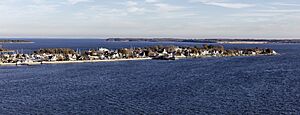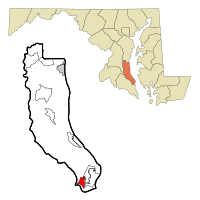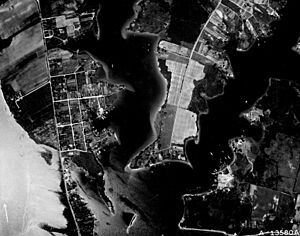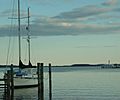Solomons, Maryland facts for kids
Quick facts for kids
Solomons, Maryland
|
|
|---|---|

Solomons from the Thomas Johnson Bridge in 2023
|
|

Location of Solomons, Maryland
|
|
| Country | United States |
| State | Maryland |
| County | Calvert |
| Area | |
| • Total | 2.34 sq mi (6.05 km2) |
| • Land | 1.99 sq mi (5.16 km2) |
| • Water | 0.34 sq mi (0.89 km2) |
| Elevation | 0 ft (0 m) |
| Population
(2024)
|
|
| • Total | 2,221 |
| • Density | 1,330.99/sq mi (514.02/km2) |
| Time zone | UTC−5 (Eastern (EST)) |
| • Summer (DST) | UTC−4 (EDT) |
| ZIP code |
20688
|
| Area code(s) | 410, 443, and 667 |
| FIPS code | 24-73325 |
| GNIS feature ID | 1676619 |
Solomons, also known as Solomons Island, is a small community in Calvert County, Maryland, United States. It's a popular spot for weekend trips, especially for people from the Baltimore and Washington D.C. areas. In 2024, about 2,221 people lived here.
Contents
Exploring Solomons: Location and Land
Solomons is found at the very southern tip of Calvert County. It includes Solomons Island itself and the nearby mainland. This area is located where the Patuxent River meets the Chesapeake Bay.
Right across the river is the U.S. Naval Air Station Patuxent River. Solomons also covers parts of the Dowell Peninsula. The total area of Solomons is about 6 square kilometers (2.3 square miles). Most of this is land, but about 0.9 square kilometers (0.34 square miles) is water. This water includes Back Creek, which is a tidal inlet connected to the Patuxent River.
Solomons Weather: A Look at the Climate
The weather in Solomons features hot and humid summers. Winters are generally mild to cool. This type of weather is called a humid subtropical climate.
- In January, the average temperature is about 3.7 degrees Celsius (38 degrees Fahrenheit).
- In July, the average temperature is around 25.9 degrees Celsius (78.7 degrees Fahrenheit).
| Climate data for Solomons, Maryland (1991–2020 normals, extremes 1893–present) | |||||||||||||
|---|---|---|---|---|---|---|---|---|---|---|---|---|---|
| Month | Jan | Feb | Mar | Apr | May | Jun | Jul | Aug | Sep | Oct | Nov | Dec | Year |
| Record high °F (°C) | 76 (24) |
79 (26) |
89 (32) |
91 (33) |
100 (38) |
99 (37) |
103 (39) |
104 (40) |
99 (37) |
95 (35) |
82 (28) |
75 (24) |
104 (40) |
| Mean daily maximum °F (°C) | 45.3 (7.4) |
47.6 (8.7) |
54.9 (12.7) |
65.4 (18.6) |
74.2 (23.4) |
83.8 (28.8) |
87.9 (31.1) |
86.3 (30.2) |
79.9 (26.6) |
68.7 (20.4) |
58.6 (14.8) |
50.1 (10.1) |
66.9 (19.4) |
| Daily mean °F (°C) | 37.7 (3.2) |
39.2 (4.0) |
46.3 (7.9) |
56.4 (13.6) |
66.0 (18.9) |
75.7 (24.3) |
80.3 (26.8) |
78.7 (25.9) |
72.4 (22.4) |
61.0 (16.1) |
50.8 (10.4) |
42.3 (5.7) |
58.9 (14.9) |
| Mean daily minimum °F (°C) | 30.1 (−1.1) |
30.8 (−0.7) |
37.6 (3.1) |
47.4 (8.6) |
57.9 (14.4) |
67.6 (19.8) |
72.7 (22.6) |
71.0 (21.7) |
65.0 (18.3) |
53.4 (11.9) |
43.0 (6.1) |
34.5 (1.4) |
50.9 (10.5) |
| Record low °F (°C) | −3 (−19) |
−5 (−21) |
10 (−12) |
17 (−8) |
32 (0) |
47 (8) |
53 (12) |
49 (9) |
43 (6) |
30 (−1) |
13 (−11) |
−1 (−18) |
−5 (−21) |
| Source: NOAA | |||||||||||||
Solomons' Past: A Journey Through History
Solomons has a long history, going back to colonial times. It was first called Bourne's Island in 1680, then Somervell's Island in 1740. The name Solomons comes from Isaac Solomon, a businessman from Baltimore. He started a cannery there after the American Civil War. His old home can still be seen on the island.
Shipbuilding and Water Activities
In the 1800s, shipyards grew in Solomons to support the local fishing boats. The Marsh Shipyard was famous for building "bugeyes." These were a type of boat that came before the "skipjack."
During the War of 1812, Joshua Barney, a naval officer, sailed his fleet from Solomons. He used the deep, safe harbor to attack British ships in the Chesapeake Bay. Solomons has been a busy marine center ever since.
Solomons' Role in World War II
During World War II, Solomons was chosen as an important training site for the U.S. Navy. This was called the Naval Amphibious Training Base Solomons. Soldiers learned skills here that were very important for major battles like D-Day and Guadalcanal.
Three naval bases were set up near the Patuxent River. These bases helped a lot with the war effort. They also created many new jobs for people living nearby. From 1942 to 1945, the number of people in Solomons grew from 263 to over 2,600. More than 60,000 troops trained at Solomons during the war.
Interestingly, many soldiers who trained in Solomons, Maryland, were later sent to fight in the Solomon Islands in the Pacific Ocean.
Connecting Solomons: The Governor Thomas Johnson Bridge
For a long time, Solomons was a quiet town known for building boats. It was also home to the University of Maryland's Chesapeake Biological Laboratory. In 1977, the Governor Thomas Johnson Bridge was built. This bridge connected Solomons Island to St. Mary's County and the Patuxent Naval Air Station. The bridge helped Solomons become more connected and accessible.
Fun Things to Do: Tourism in Solomons
Today, Solomons is a welcoming place for visitors. It has many marinas where boats can dock. There are also lots of seafood restaurants and gift shops. You can enjoy a walk along the boardwalk or visit a sculpture garden.
The Calvert Marine Museum is a popular spot. Here, you can climb a former lighthouse and take boat rides. The museum also hosts outdoor concerts with famous performers. Solomons has hotels, a U.S. Navy family recreation center, and a church retirement home. St. Peter's Chapel, built in 1889, is a historic church that is still used today.
Annmarie Sculpture Garden & Arts Center
The Annmarie Sculpture Garden & Arts Center is a special place in Solomons. It's connected to the Smithsonian Institution. This park has sculptures hidden among the trees. You can see amazing artworks by famous artists like Kenneth Snelson and George Rickey. Many sculptures are on loan from the National Gallery of Art or the Hirshhorn Museum.
The garden is great for families, with fun activities for kids. It also displays world-class art, including pieces by Picasso, Matisse, and Miró. Outside the Arts Building, there's a bronze fountain sculpture. It shows a Chesapeake Bay waterman holding oyster-harvesting tools. Water flows from the tools and into a pool shaped like a map. Since 1993, Annmarie Garden has hosted an art festival outdoors. About 100 artists come to sell their creations during this weekend event.
People of Solomons: Demographics
| Historical population | |||
|---|---|---|---|
| Census | Pop. | %± | |
| 2020 | 2,650 | — | |
| U.S. Decennial Census | |||
In 2000, there were 1,536 people living in Solomons. There were 689 households, and 378 of these were families. The population density was about 856 people per square mile (330 people per square kilometer).
Most of the people living in Solomons were White (90.69%). About 6.64% were African American, and smaller percentages were Native American, Asian, or from other backgrounds. About 0.78% of the population was Hispanic or Latino.
In 2000, Solomons had the highest percentage of people with Welsh heritage in Maryland, at 6.7%.
- About 15.4% of households had children under 18.
- 47.8% of households were married couples.
- 45.1% of households were not families.
- 39.0% of households were people living alone.
- 24.8% of households had someone aged 65 or older living alone.
The average household had 1.97 people, and the average family had 2.56 people. The median age in Solomons was 56 years old. This means half the people were younger than 56, and half were older.
Images for kids
See also
 In Spanish: Solomons (Maryland) para niños
In Spanish: Solomons (Maryland) para niños








